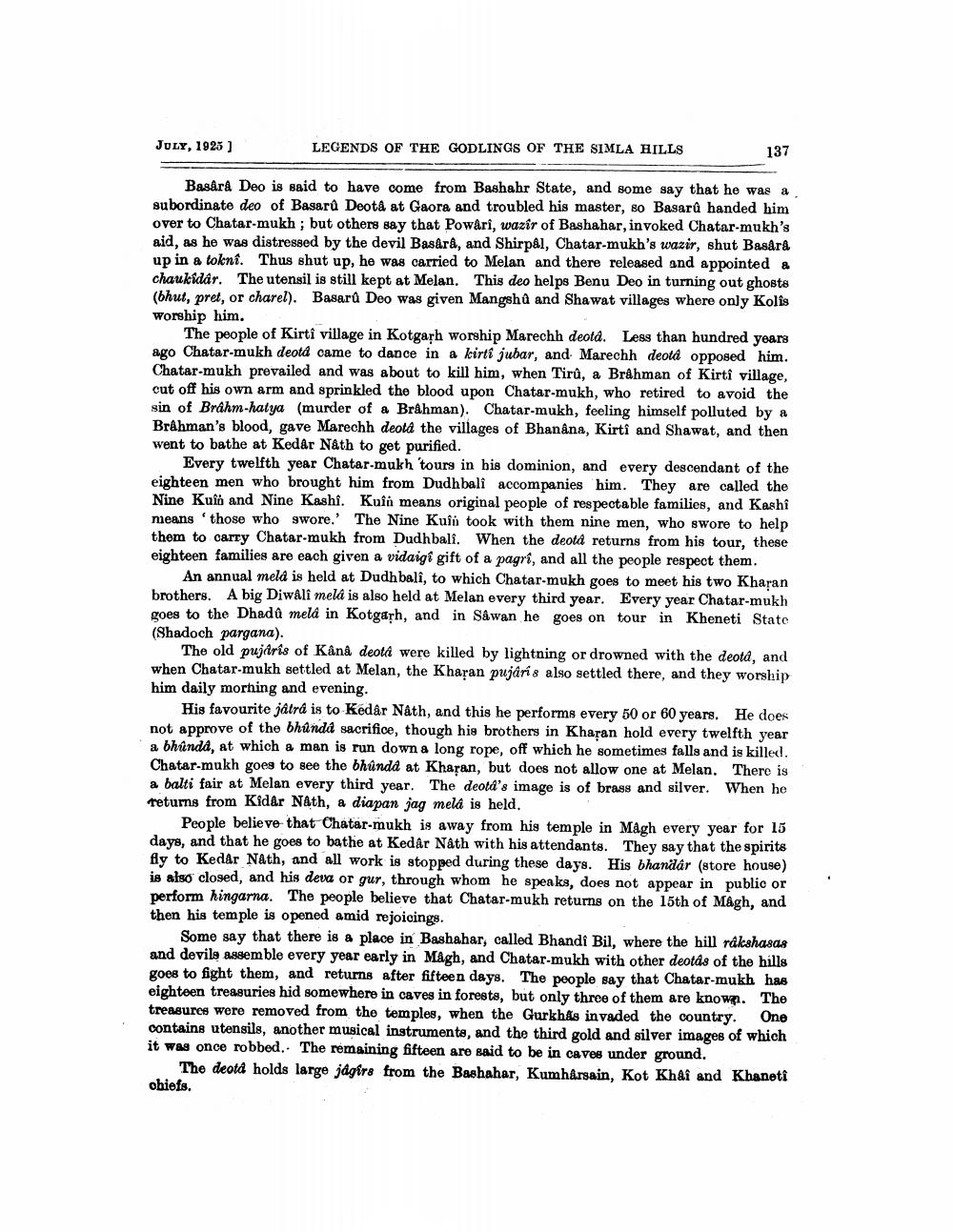________________
JULY, 1925 ]
LEGENDS OF THE GODLINGS OF THE SIMLA HILLS
137
Basârâ Deo is said to have come from Bashahr State, and some say that he was a subordinate deo of Basarů Deota at Gaora and troubled his master, 8o Basarû handed him over to Chatar-mukh; but others say that Powâri, wazir of Bashahar, invoked Chatar-mukh's aid, as he was distressed by the devil Basårå, and Shirpal, Chatar-mukh's wazir, shut Basara up in a tokni. Thus shut up, he was carried to Melan and there released and appointed & chaukidar. The utensil is still kept at Melan. This deo helps Benu Deo in turning out ghosts (bhut, pret, or charel). Basarû Deo was given Mangshû and Shawat villages where only Kolis worship him.
The people of Kirti village in Kotgarh worship Marechh deota. Less than hundred years ago Chatar-mukh deotd came to dance in a kirti jubar, and Marechh deota opposed him. Chatar-mukh prevailed and was about to kill him, when Tirû, a Brahman of Kirti village, cut off his own arm and sprinkled the blood upon Chatar-mukh, who retired to avoid the sin of Brahm-hatya (murder of a Brahman). Chatar-mukh, feeling himself polluted by a Brahman's blood, gave Marechh deota the villages of Bhanâna, Kirti and Shawat, and then went to bathe at Kedar Nath to get purified.
Every twelfth year Chatar-mukh 'tours in his dominion, and every descendant of the eighteen men who brought him from Dudh bali accompanies him. They are called the Nine Kuio and Nine Kashi. Kuin means original people of respectable families, and Kashi means those who wore. The Nine Kuin took with them nine men, who swore to help them to carry Chatar-mukh from Dudhbali. When the deotá returns from his tour, these eighteen families are each given a vidaigi gift of a pagri, and all the people respect them.
An annual meld is held at Dudh bali, to which Chatar-mukh goes to meet his two Kharan brothers. A big Diwali melá is also held at Melan every third year. Every year Chatar-mukh goes to the Dhada meld in Kotgarh, and in Sâwan he goes on tour in Kheneti State (Shadoch pargana).
The old pujaris of Kânå deota were killed by lightning or drowned with the deotd, and when Chatar-mukh settled at Melan, the Kharan pujárís also settled there, and they worship him daily morning and evening.
His favourite jätra is to Kedâr Náth, and this he performs every 50 or 60 years. He does not approve of the bhunda sacrifice, though his brothers in Kharan hold every twelfth year a bhända, at which a man is run down a long rope, off which he sometimes falls and is killed. Chatar-mukh goes to see the bhündå at Kharan, but does not allow one at Melan. There is a balti fair at Melan every third year. The deotd's image is of brass and silver. When he Teturns from Kidâr Nath, a diapan jag melá is held.
People believe that Chatar-mukh is away from his temple in Magh every year for 15 days, and that he goes to bathe at Kedar Nath with his attendants. They say that the spirits fly to Kedar Nath, and all work is stopped during these days. His bhandar (store house) is also closed, and his deva or gur, through whom he speaks, does not appear in public or perform hingarna. The people believe that Chatar-mukh returns on the 15th of Magh, and then his temple is opened amid rejoicings.
Some say that there is a place in Bashahar, called Bhandi Bil, where the hill rakshasas and devils assemble every year early in Magh, and Chatar-mukh with other deotds of the hills goes to fight them, and returns after fifteen days. The people say that Chatar-mukh has eighteen treasuries hid somewhere in caves in forests, but only three of them are known. The treasures were removed from the temples, when the Gurkhås invaded the country. One contains utensils, another musical instruments, and the third gold and silver images of which it was once robbed. The remaining fifteen are said to be in caves under ground.
The deota holds large jagers from the Bashahar, Kumhårsain, Kot Khai and Khaneti ohiefs.




